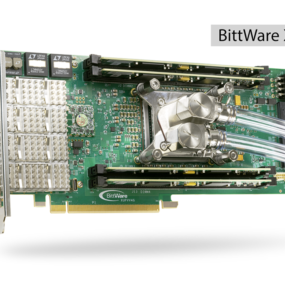Supported Hardware / Recommended FPGA Hardware
BTC
- Bittware CVP-13 water cooled card. This is the most powerful FPGA available. You can read more about it here. It has the Xilinx VU13P FPGA and it can provide 300 amps of current to the FPGA. With 46% more logic and 30% more on-chip memory, plus the bigger power supply, the CVP-13 is about 50% faster than the BCU1525 (VU9 FPGA). The board costs $5750-$6000 depending on the type of cooling. You can buy it here: https://store.mineority.io/sqrl/cvp13/ The VU13P FPGA is big enough to run the X16R (550-650MH/s) and X17 (710MH/s) algorithms, although Zetheron Technology will not have these algorithms completed until Spring 2019.
- Bittware XUPVV4-VU9P or watercooled versions. These boards have a current limit from 150A, but the cold temperature of the FPGA reduces power consumption, making the available 150A current equal to the hash rate of a 170A air cooled board. Available now. Price is by quotation only and you need a large order to get a good price. https://www.bittware.com/fpga/xilinx/boards/xupvv4/

3. Xilinx BCU1525. This board is a more advanced version of the original VCU1525. The BCU1525 has improved reliability and can handle currents of 190A. A large group order of 5000 units was done by Squirrels Research/FPGA.land/Mineority.io. You can buy this board here for $3600: https://store.mineority.io/sqrl/bcu1525/
4. Xilinx VCU1525. This is the original board used for development of FPGA mining bitstreams and still supported by Zetheron and others. This board can handle 170A safely. However, as this board was not specifically designed for crypto-mining loads, the reliability and safe power limits of this board are inferior to the boards mentioned above. Contact Jason.Harvey@Avnet.com for ordering information. Lead time is currently 6-8 weeks for the actively cooled version which is the one we recommend. Please note that you need to lower the core voltage of this board to achieve full hash speed and this is explained in the downloads section.
5. Accessories and Cooling: We recommend buying accessories from https://shop.fpga.guide. From them, you can buy the custom water cooling block ($199) for the VCU1525/BCU1525, as well as a modded DC1613A cable to change the core voltage on the BCU1525/VCU1525. On a stock VCU1525, the hash rate is doubled by using the water block and modifying the core voltage.
6. If you are looking to play with a mid-range FPGA card, you can try the Avnet AES-KU040. We support this board with most of our algorithms, although if run in ‘stock’ mode, the hash rate is very low. If you are willing to make extensive modifications to the power supply and heat sink, the board achieves very good performance equal to about 25% the speed of the BCU1525. You can buy it here. You can see a video of the modded board here. If you expect to make any type of ROI do not buy this board unless you are very skilled with a soldering iron and electrical modifications!
7. Mid-range FPGA cards. Within the next 2-3 months, at least two companies will be releasing mid-range FPGA cards ($479-$995) that have excellent ROI (150-200 days). Zetheron will be supporting these cards with our algorithms.
8. Immersion cooling. Maximum performance from an FPGA card is achieved by immersing the card in a non-conductive (dielectric) liquid such as EC-100 or BC-888. Previously, people used two-phase liquids such as Novec 7100 which are designed to ‘boil’ at 65C and require complex condensation systems. The new liquids (BC-888 and EC-100) are single phase (they don’t boil) and are simple enough and safe enough to use at home. You can buy them for about $9-$14 per liter here.
Bitstreams are Unique to Each Board
As explained in the Overview section, FPGA software is hard-coded to a single piece of hardware. It is not possible to ‘run’ a single build of FPGA software on different devices. The hardware devices Zetheron has chosen to support have been carefully selected in terms of favorable price-to-performance ratio (ROI, return on investment).Porting software from one FPGA board to another is a tremendously time consuming task. If you happen to come across a different piece of FPGA hardware (not on the ‘supported’ list), and are hoping that someone will be able to ‘port’ the software to your board, that is unlikely to happen as the effort required is tremendous.
Even hardware platforms with the same FPGA required extensive work to support. At the moment the primary FPGA’s supported by the Zetheron mining platform are the VU9P, VU13P, KU040, KU5P and KU15P. However, just because you see a random FPGA card that has one of those FPGA’s, it won’t be compatible with our software because:
(1) Each FPGA comes in different variants with differing number of pins, and different rated heat/power dissipation.
(2) The pins to which the manufacturer has connected the clocks, reset, and USB-UART pins are different, and the clock sources are of a different frequency.
(3) Each board has different power limits. Since mining requires more power than classical FPGA applications, most existing boards simply cannot provide enough current to the FPGA.
(4) Different boards use different methods to interface with the external environment. The Zetheron software expects a USB-UART interface with either an FTDI (FTXXXX) or Silicon Labs (CP21XX) interface IC. Some boards do not have USB-UART interfaces at all, and only support PCIe or gigabit ethernet interfaces.


